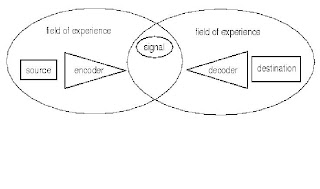Communication is the passing on of ideas and information. In business, it is essential to have good clear channels of communication. Communication is only successful when the intended result is achieved. This effectiveness is dependent on the choice of recipient, the clarity of the message and the choice of communication medium. www.compad.com.au/cms/prinfluences/articles/
It would be inefficient and wasteful to send a message to every distributor regarding every single issue, particularly if some issues only concerned a few individuals.
Effective communication at Amway, therefore, involves making prior decisions about who needs to receive the message. Sometimes it is necessary to repeat a message.
For example: - In the classroom, a lecturer will attempt to explain a task in clear and simple terms, but if students are unsure about the message, he will rephrase it until the students understand. Repeating messages through a different communication channel can also aid the target market's understanding.
The Importance of Communication In Small Business: -
Many small businesses fail because of small communication mistakes that could have been easily handled by employees. This is not an uncommon occurrence in the business world. Some of the top companies that are out there have great communication. In fact, employers look for the communication as the top skill when hiring students, or employees. Why is it so vital to a company’s success that you have great communication skills? Well, think of it this way. If you cannot communicate an issue that is happening to your manager, then he cannot take care of it and the problem persists. This problem can be minute, or major. Either way, overlooking it and not voicing a concern can be detrimental to a small or even a large business.www.expresscomputeronline.com/20050207/technologylife01.shtml
How to Avoid Small Business Communication Problems
One way to avoid this is to hire college graduates. Many college graduates that have lived on campus have gained more than just a bachelor's degree. They have gained an enormous edge in communication. Many schools require a communication course as part of the curriculum. Otherwise, students interact in activities with a diverse college environment giving them the ability to voice concerns in a business setting. Communication that is learned in classroom, and other methods from a college environment can help your small business grow.
Relevance for employees: -
Today's employees want to participate in decision-making, or at least they want to be informed about decisions affecting them in a timely manner. Internal communications strategies, developed by the corporate communication function, make sure the workforce is more engaged, productive, and loyal - because it feels informed. Internal communications should make sure employees get information, which is affecting them before the public gets it. For example, when GM announced to lay off 30,000 workers in 2005, the company had to communicate this to its employees before informing the public (http://www.foxnews.com/story/0,2933,176199,00.html
Relevance for investors
Investors need information about the company, otherwise the investments become too risky and they would withdraw their money. IR professionals interact with individual and institutional investors and are involved with the financial statements and annual reports. Look at the example of Boeing: the homepage's investor relation’s subsection offers a great deal of information for investors (http://www.boeing.com/companyoffices/financial/). In competition for capital, corporations need to communicate with investors and potential investors.
Relevance for communities
Companies increasingly take more responsibilities in communities in which they operate. Globalization and international corporate expansion have increased constituents' expectations for corporate citizenship. Many companies are publishing environmental and social performance information. The corporate communications department is involved in this task. For example, look at Exxon Mobil’s initiatives in corporate citizenship (http://www.exxonmobil.com/Corporate/Citizenship/gcr_mainpage_categories.asp).
References: -
www.compad.com.au/cms/prinfluences/articles/
www.expresscomputeronline.com/20050207/technologylife01.shtml
(http://www.foxnews.com/story/0,2933,176199,00.html
(http://www.boeing.com/companyoffices/financial/). http://www.exxonmobil.com/Corporate/Citizenship/gcr_mainpage_categories.asp)










